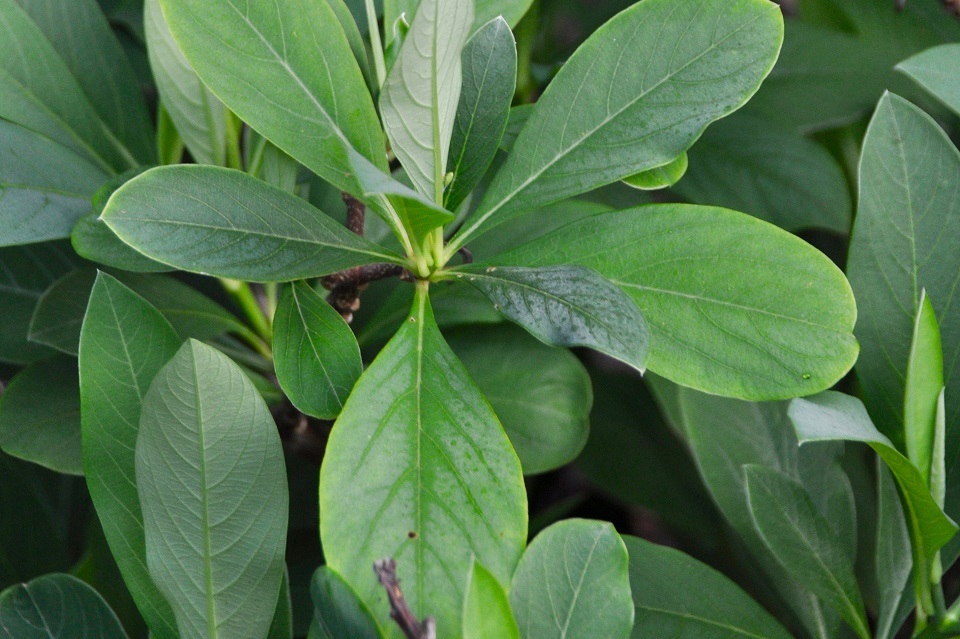
A Four-Season Plant
From the UT Gardens
December 2016 Plant of the Month: Edgeworthia
Submitted by Andy Pulte, UT Department of Plant Sciences
I first wrote about Edgeworthia or paperbush as a plant of the month five years ago. I wrote about it then because it was one of my absolute favorite plants, and today it continues to be towards the top of the list of plants I love. I feel as if I’ve learned more about growing this plant in Tennessee since that first article and believe it’s worth sharing. December may not be the perfect month to talk about Edgeworthia, its leaves have already turned buttery yellow, fallen and are now showing bare stems. However, the stage is being set for a wonderful transition, and the opening act starts now. By the end of the year, those bare stems will develop tightly packed tubular flower buds. As the new year develops, buds will become sweet-smelling candelabras of beautiful yellow flowers.
In its native China, you would find Edgeworthia clinging to stream banks and hovering on the edge of woodlands. Here in the Mid South, partial shade or more shade is a must for the plant to be successful. It will find a happy home in areas with rich organic soils that don’t completely dry out. Edgeworthia quickly makes a multi-stemmed woody shrub when provided the right growing conditions. Final size of plants is hard to predict, with most I’ve seen in Tennessee hovering under 6 feet high and wide (often growing 8 feet or more). Training a plant to a single stem also can be a nice effect. Those familiar with the closely related plant Daphne might recognize some similar characteristics.
When I was first introduced to this plant I made the assumption that its common name, paperbush, was given to it because of its paper-thin leaves. However, the common name refers to paper products made from the woody bark and stem of the plant.
In a 1920 edition of the Paper Trade Journal, Clarence Jay West lists reading suggestions for different paper-making materials. He lists several references from the late 1800s on Edgeworthia in places like Nepal, Japan and China. He also states that Edgeworthia and Daphne are good choices for fine paper when strength is also required. In fact, Japanese bank notes are made in part of an Edgeworthia paper called misumata.
For those interested in botanical nomenclature and taxonomy, you will run into unfortunate confusion with this plant. You will most often find Edgeworthia chrysantha in the trade; its leaves are of a good size and flowers are showy. You may also run into Edgeworthia papyrifera, which is sometimes used as a synonym for E. chrysantha or to refer to a plant with overall smaller characteristics. (It is most likely a diploid form of E. chrysantha.) Additionally, in some specialty nurseries you will find cultivars like ‘Rubra’ or ‘Red Dragon’ that produce reddish-orange flowers. These red-flowering plants tend to have leaves that are slightly less attractive and do not demonstrate the vigor or ease of growth found in other E. chrysantha.
Edgeworthia is truly a four-season plant. In the summer, the plant is covered in beautiful elongated 5-inch leaves that hold droplets of water on a finely pubescent surface. In fall, leaves drop to reveal a beautifully structured plant that develops sweet-smelling winter flowers.
Edgeworthia is hardy for almost all in the state of Tennessee when it is sited properly. Spring planting seems to be the trick to getting it off to the right start. However, this plant is by no means perfect – cold or desiccation can knock-out flowers just at the height of anticipation. Two cultivars of note are ‘Snow Cream’ known for having bigger flowers and ‘Nanjing Gold’ which is reported to have a more pronounced golden color in the flowers.
Edgeworthia specimens can be found in the UT Gardens in Knoxville and Jackson. In Knoxville it’s located in the bottom garden room near Neyland Drive. In Jackson, look for it on the north side of the main building near the gazebo.
The UT Gardens includes plant collections located in Knoxville, Jackson and Crossville. Designated as the official botanical garden for the State of Tennessee, the collections are part of the UT Institute of Agriculture. The gardens’ mission is to foster appreciation, education and stewardship of plants through garden displays, educational programs and research trials. The gardens are open during all seasons and free to the public. For more information, see the Gardens website: utgardens.tennessee.edu
Through its mission of research, teaching and extension, the University of Tennessee Institute of Agriculture (UTIA) touches lives and provides Real. Life. Solutions. ag.tennessee.edu
Contact:
Andy Pulte, UT Department of Plant Sciences, 865-974-7324